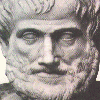

Aristarchus was born on the island of Samos around 320 BC. He is believed to have studied and lived in Alexandria, where he died ca. 250 BC. A mathematician at least as much as an astronomer, he belonged to the so-called Pythagorean school of thought, which sought to understand the universe in terms of geometrical and arithmetical relationships.
Aristarchus' only surviving text is his Treatise on the Sizes and Distances of the Sun and Moon . However, largely through the writings of Archimedes (287-212 BC) and Plutarch, Aristarchus is known to have the first proponent of the heliocentric hypothesis, with the Earth ascribed a movement of orbital rotation about the Sun, as well as a daily axial rotation. Aristarchus argued that the lack of observed annual parallax in the fixed stars could be explained, within his heliocentric model, by assuming that the distance to the fixed stars is very much larger than the size of the Earth's orbit. The very same argument was to be made by Nicholas Copernicus , seventeen centuries later.
Porter, R. (ed.) 1994, The biographical dictionary of scientists , Oxford University Press
| Chronological menu | Biographical index | Index of images |